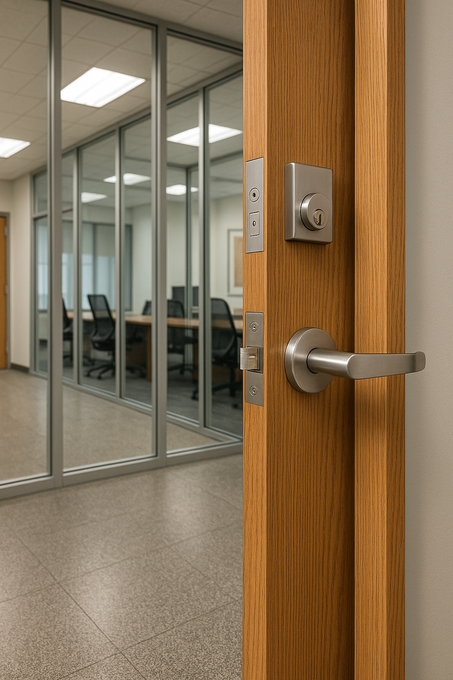
What Is Grade 1 Lock Hardware?
Posted by National Lock Supply on Oct 24th 2025
When choosing locks for a commercial or residential project, you’ve probably seen labels like Grade 1, Grade 2, or Grade 3 in the specifications. These aren’t marketing terms—they’re official ratings defined by the ANSI/BHMA standards that measure how durable, secure, and reliable a lock really is.
Grade 1 lock hardware represents the highest level of performance and security available in the United States. It’s the preferred choice for schools, hospitals, office buildings, and any facility that handles heavy daily use or requires maximum protection.
Understanding ANSI/BHMA Lock Grades
Locks in the U.S. are tested and certified by two organizations:
- ANSI (American National Standards Institute) — sets national testing protocols.
- BHMA (Builders Hardware Manufacturers Association) — conducts the mechanical and security performance tests.
These organizations evaluate each lock for cycle endurance, bolt and latch strength, impact resistance, torque performance, and tamper protection. After testing, each product receives a grade that defines its intended level of use:
|
Grade |
Use Type |
Common Application |
Cycle Test |
|
Grade 1 |
Heavy-duty |
Schools, hospitals, public buildings |
1,000,000+ cycles |
|
Grade 2 |
Medium-duty |
Offices, apartments |
400,000–800,000 cycles |
|
Grade 3 |
Light-duty |
Residential doors |
200,000 cycles |
What Makes a Lock Grade 1
A Grade 1 lock is engineered for continuous, high-traffic operation. These locks are built from solid brass, stainless steel, or cast metal components that resist wear, corrosion, and impact.
Each model must pass over one million opening and closing cycles during testing—more than double what Grade 2 hardware requires. Grade 1 deadbolts and levers also feature reinforced bolts and heavy-duty torque mechanisms, making them harder to twist, pry, or force open. Many include anti-drill plates and hardened cylinders to improve pick and tamper resistance.
In short, Grade 1 hardware offers true commercial strength, designed for years of service with minimal maintenance.
Where Grade 1 Locks Are Used
Grade 1 hardware is the benchmark for doors that demand constant operation and maximum reliability. These locks are standard on main entry doors in commercial buildings, classroom and corridor doors in schools, patient rooms and staff areas in hospitals, and in government or municipal facilities. They’re also used on exterior doors in retail stores and office complexes, where security and performance can’t be compromised.
Grade 1 certification applies to a variety of hardware types, including deadbolts, cylindrical lever locks, mortise locks, and panic exit devices, all tested under ANSI/BHMA A156 standards to guarantee consistent performance across product categories.
How to Identify Grade 1 Hardware
Spotting genuine Grade 1 hardware is easy if you know what to look for. Product listings and packaging should clearly state “ANSI/BHMA Grade 1 Certified” or “Meets ANSI A156.2 / A156.13.” Locks may also carry certification labels from BHMA or UL, confirming that they’ve passed independent testing for cycle life, torque resistance, and security strength.
Leading manufacturers such as Yale, Schlage, Corbin Russwin, Sargent, and Best Access produce a full range of certified Grade 1 locks. All are available through National Lock Supply, where you can source authentic, code-compliant hardware for commercial and institutional projects.
Why Grade 1 Hardware Matters
Investing in Grade 1 lock hardware delivers real-world advantages: longer service life, reduced maintenance, and proven security that stands up to constant use. For facility managers and contractors, this means fewer replacements, lower lifecycle costs, and full compliance with safety regulations.
Whether you’re upgrading school doors, outfitting a new office, or securing a hospital wing, Grade 1 locks provide the confidence that only top-tier hardware can deliver.
FAQS
1. What does Grade 1 mean on a lock?
Grade 1 is the highest performance rating under ANSI/BHMA standards, indicating a lock that has passed over 1 million operating cycles and meets the toughest tests for strength, durability, and security. It’s typically used on commercial and institutional doors that see heavy daily use.
2. What’s the difference between Grade 1, Grade 2, and Grade 3 locks?
Grade 1 locks are commercial-grade, built for maximum durability and high-traffic use. Grade 2 hardware suits moderate traffic in offices or apartments, while Grade 3 locks are designed for light residential use. The higher the grade, the stronger and longer-lasting the lock.
3. Where should I install Grade 1 hardware?
Use Grade 1 locks on main entry doors, school classrooms, hospital corridors, government buildings, and high-security exterior doors. These environments demand long-term reliability and compliance with fire and safety codes.
4. Are Grade 1 locks more secure?
Yes. Grade 1 hardware features reinforced bolts, hardened steel components, and advanced torque resistance, offering greater protection against forced entry and tampering compared to lower grades.
5. How can I tell if a lock is Grade 1 certified?
Look for markings such as “ANSI/BHMA Grade 1 Certified” or references to ANSI A156.2 / A156.13 standards. Many products also carry BHMA or UL certification labels to confirm independent testing.
6. Are Grade 1 locks worth the cost?
Absolutely. While more expensive upfront, Grade 1 locks last significantly longer and reduce maintenance and replacement costs over time, making them the most cost-effective option for commercial applications.
 SAME DAY & EXPEDITED SHIPPING AVAILABLE
SAME DAY & EXPEDITED SHIPPING AVAILABLE





